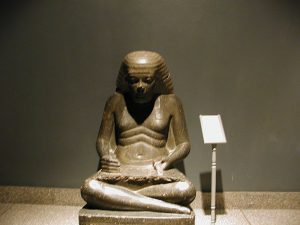This article gives brief information on ancient Egyptian glossary of words, phrases and ancient Egyptian terms, vocabulary
Egyptian is a “dead” language, related to the Semitic languages. Today, the people of Egypt speak Arabic. But Egyptian was spoken for over 3000 years. And, over the years, it had several written forms:

Hieroglyphics: The form found on monuments, and some papyri.
Hieratic: This is script hieroglyphics. It’s from varied over the centuries.
Demotic: This was a later script version of Egyptian which was not based on hieroglyphics, but was phonetic.
Coptic: This was a late version of Egyptian which used the Greek alphabet, plus a few added characters.
Egyptian signs were of two types, phonetic signs, like these (along with many signs which were combinations of two or three sounds), and determinatives, signs which gave a clue to the meaning of the word. Most words in ancient Egypt were made up of phonetic signs, followed by one determinative. A few had two or three determinatives.
Some very common words had no determinative. And, some other common words were written as just the determinative, with no phonetic signs. And there are common abbreviations, in which one or two signs stand for an entire word or phrase.
The vowels “a” (ah), “i” (ee), and “u” (oo) were written and were evidently considered soft consonants. But just pronounce them as vowels. The “u” (oo) sound is now normally written as “w”, although it normally has a w sound only at the beginning of some words (“wat” or “wi”). A short eh sound is normally added to make words pronounceable: “nfr” becomes “nefer”, “Imn” becomes “Amen” or “Amun” (an i at the beginning of a word was often pronounced a), “tn” is “ten”, “pt” is “pet”, “htp” is “hetep”.
Some common ancient Egyptian words:
BASTET. . A cat headed goddess. As a sun goddess, she represents the warm, life giving a power of the sun.
BAKHU. . The mythical mountain from which the sun rose. The region of the eastern horizon. One of two mountains that held up the sky, the other being Manu. These peaks were guarded by the double lion god, Aker.
FAIENCE. . A glazed material, with a base of either carved soapstone or molded clay, with an overlay of blue/green colored glass.
FALSE DOOR. A door carved or painted on a wall. The ka would use this door to partake of funerary offerings.
IBU. . The tent of purification. This is the place where mummification was performed.
KHU . A spiritual entity often mentioned in association with the ba. It was viewed as an entirely spiritual and absolutely immortal being.
